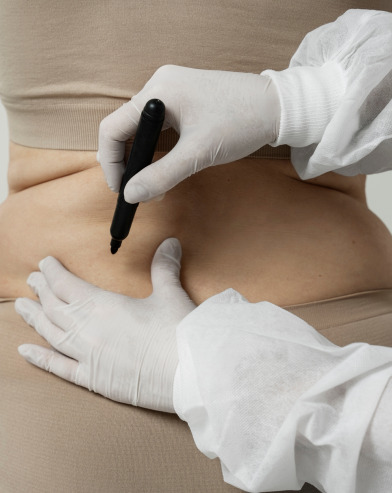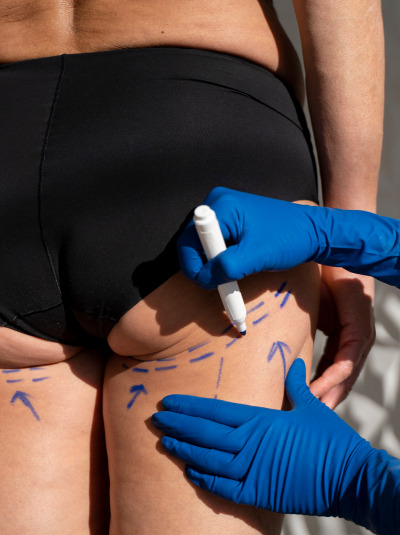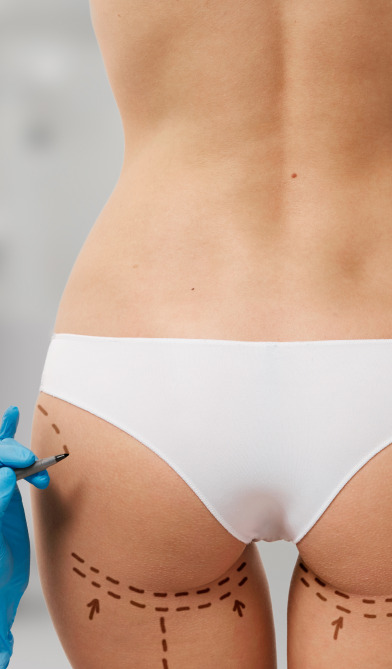While liposuction surgery is a complex process that must be performed by a certified plastic surgeon, anyone can understand how it works. From suction-assisted liposuction to Laser-assisted liposuction (LAL), all liposuction types have the same goal.
Fortunately, Parfaire Medical Aesthetics has extensive experience offering liposuction surgery, and can address all of the most important questions you may have about the different types of liposuction.

How Does Liposuction Work?
Liposuction works by suctioning unwanted fat cells from various areas of the body. This process, otherwise known as contouring, allows patients to shape the desired area by lowering the number of fat cells.
Common areas of treatment include:
- Face and jowls
- Chin and neck
- Arms
- Abdomen
- Back
- Thighs
- Full body
During the liposuction treatment, a plastic surgeon makes a small incision in your skin where a tube called a cannula will be inserted. The cannula specializes in fat removal, as it suctions out unwanted fat and sculps the targeted area.
Afterward, the skin molds itself to fit the new area. Hopefully, if skin tone and laxity are adequate, it will successfully match the body contouring achieved through liposuction.
While the removal of excess fat will result in some weight loss, it’s important to note that the process is not a weight-loss method or a weight-loss alternative. Instead, liposuction focuses on the shaping and contouring aspects of fat removal. This is especially useful for those who’ve undergone bariatric surgery, or have already achieved weight loss through other methods.
Why Is Liposuction Performed?
Liposuction is performed for cosmetic or medically necessary purposes. In the latter case, many patients who’ve undergone bariatric surgery or significant weight loss through other methods may need liposuction. For these individuals, liposuction alone or in combination with skin-removal surgery is often medically necessary.
For others who are just looking to remove excess fat, liposuction is performed on areas of the body that don’t respond to diet and exercise. These areas include:
- Chin and neck
- Upper arms
- Chest and back
- Enlarged male breast tissue
- Abdomen
- Buttocks
- Hips and thighs
- Calves and ankles
On the other hand, liposuction does not reduce dimpled skin from cellulite or other cosmetic issues with the skin’s surface. This also includes stretch marks, which liposuction cannot remove.
What Are The Different Types Of Liposuction?
How your liposuction procedure works depends on which liposuction technique your surgeon uses. Liposuction techniques will vary based on your goals, the treatment area, and whether you have undergone liposuction treatment in the past.
Here are the different types of liposuction outlined:
- Tumescent liposuction
- Saltwater. Facilitates fat removal
- Lidocaine. A local anesthetic
- Epinephrine. Contracts the blood vessels
This is the most common liposuction technique. First, the plastic surgeon injects a blend of saltwater and two vital medications into the targeted area. All of these serve a purpose.
After these medications are administered, the surgeon can remove fat more easily and safely.
- Suction-assisted liposuction
- Laser-assisted liposuction (LAL)
- Ultrasound-assisted liposuction (UAL)
- Power-assisted liposuction (PAL)
This is another one of the most frequently used liposuction techniques. Just like with Tumescent liposuction, a surgeon will first administer the three medications mentioned above.
After these medications are administered, the surgeon makes small incisions in the skin and introduces the cannula beneath the skin. Linked to a vacuum, this slender tube draws fat and fluids from the body.
During LAL your surgeon will utilize powerful laser lights on a small, flexible tube (fiber). Rather than suctioning fat, the laser will break it down and turn it into liquid. This makes allows for easy fat removal, and only requires a very small incision.
In the case of UAL, the surgeon introduces a metal rod beneath the skin that applies ultrasonic energy. Similarly to LAL, this energy liquifies fat cells so they can be removed easily.
A common type of UAL you may encounter is a Vibration Amplification of Sound Energy at Resonance (VASER)-assisted liposuction. This treatment involves a machine that enhances skin shaping.
This type of liposuction employs a compact, stainless steel tool (cannula) that oscillates back and forth quickly across your fat to break it up. This tool provides another method for easier fat removal and enhances the precision of the procedure.
Most commonly PAL is used when you’ve received a liposuction before, or if you have a large quantity of excessive fat.
The Steps Of a Liposuction Procedure
If you’re interested in pursuing a liposuction procedure, you may take comfort in knowing how your treatment will go every step of the way. Fortunately, we’ve outlined all of the steps of a liposuction procedure:
After reaching out to a plastic surgeon or surgery center of your choosing, you’ll create a consultation appointment. At this appointment, you can discuss areas of the body you want treated, as well as what your goals are. The consultation appointment will also provide you with an estimated cost.
Choosing how you’ll finance your procedure is the next step. Many plastic surgeons will offer their own financing options, but you can always reach out to a bank of your choosing.
Discuss loan terms with your ideal provider. Be sure to research how much you need to pay upfront, how much interest you should expect your loan to have, and what credit you need for approval. After you get approved, you’ll be able to set up an official appointment.
Once you arrive at your appointment, your surgeon will brief you on what you need to do and what to expect. It’s important that you’re in good physical health on the day of your appointment to avoid any complications.
An anesthesiologist will administer medications before your liposuction to ensure your comfort and safety. Depending on the procedure, you may receive local or general anesthesia. Your doctor will advise you on the most suitable choice for your treatment.
Although the incision will vary based on the treatment area, as well as the type of liposuction, there are similarities you can expect. Incisions will always be as inconspicuous and small as possible.
Initially, local anesthesia will be injected into the area to minimize bleeding and trauma. Then, the cannula will be introduced through the incision to begin fat removal.
Fat removal will depend on the liposuction technique being used. Here are the different removal methods you might expect:
- Suction-assisted liposuction. The cannula is inserted under the skin to break up the fat. Then, a high-pressure vacuum is applied to the cannula to remove excess fat cells.
- SAL. Uses a laser to dissolve the fat.
- UAL. Uses ultrasonic vibrations to produce energy that dissolves excess fat.
- PAL. Utilizes a vibrating cannula to separate even the most stubborn fat into smaller pieces.
- Water-assisted liposuction. involves a pressurized stream of saline to detach fat cells.
You’ll notice the positive effects of liposuction on the shape of your body after about a week, once the usual swelling and fluid retention diminish. During this time, sustaining a healthy diet and low-impact fitness routine is key to permanently maintaining the contour.

How to Prepare For Your Liposuction Surgery
There are important ways you can prepare for your liposuction surgery. Many of these necessities and tips will be provided by your surgeon, but we’ve also created a list you can refer to:
- Inform your surgeon about any medications you may be taking
- Ensure you take note of and follow dietary or alcohol restrictions
- Take any medications your surgeon may prescribe
- Avoid certain medicines and vitamins, such as blood thinners and nonsteroidal anti-inflammatory drugs (NSAIDs)
- Get lab testing to ensure your health and safety
- Limit, or ideally stop smoking prior to your procedure
What To Expect During Your Procedure
During your procedure, you can expect to be given either local or general anesthesia. In the case of local anesthesia, you may be given a calming medicine through an IV injection. Some common areas where local anesthesia is used include:
- Chin and neck
- Arms
- Chest
- Back
- Waist
- Thighs and hips
Alternatively, more comprehensive treatments can require general anesthesia, which will induce a sleep-like state for the length of the procedure.
Either way, the surgical team will monitor vital signs like heart rate, blood pressure, and blood oxygen levels during treatment. If you experience pain with local anesthesia, inform your surgeon for possible adjustments.
The duration of the procedure varies, lasting several hours depending on the amount of fat removed.
The duration of the procedure will vary, depending on the amount of fat being removed. However, if under general anesthesia you wake up in a recovery room and may spend a few hours under observation. If a significant amount of fluid has been removed, an overnight stay may be required to ensure hydration and prevent shock.
What To Expect After Your Procedure
After your treatment is completed, you should anticipate some discomfort, swelling, and bruising. Your surgeon may prescribe medications for pain management and infection prevention, and it’s important that you take these medications as prescribed.
Additionally, you can expect temporary fluid drainage from your incision. This is why wearing compression garments to reduce is common for the first few weeks.
Luckily, you can return to work in just a few days, and resume regular activities like sports and exercise after a few weeks.
Remember that it will take time for all changes to become apparent. Residual fat needs to settle, and it can take weeks or months for swelling to subside.
What Are Liposuction Surgery Risks?
As with cosmetic surgery, liposuction comes with certain risks you should be aware of. Remember that your surgeon, anesthesiologist, and treatment facility are professionals who will do everything in their power to mitigate these risks, but being informed is still important.
Here are rare risks you may encounter:
- Skin discoloration
- Contour deformities
- Changes in sensation
- Pain or discomfort around the treatment area
- Bruising
- Swelling
- Scarring
- Infection
- Bleeding
Be sure to discuss any concerns you have about your liposuction surgery with your surgeon before and after your treatment.

The Results Of Liposuction
Many patients are ecstatic seeing their results following liposuction, with 86% reporting an improved sense of self-esteem. After recovery, the treated area will look less bulky, slimmer, and more shapely.
Of course, results can vary depending on your age and weight gain following the procedure, as there is a reduction in skin laxity over time. However, if you can maintain a healthy weight post-procedure, your results should be long-term.
Begin Your Weight Loss Procedure Journey Today
If you’re ready for weight loss solutions and a journey toward a life free of excess fat, you’re in luck. Parfaire offers comprehensive liposuction treatments. These customizable treatments are highly effective, and performed by certified plastic surgeons.
So, if you want to tackle your excess fat, or take the next step in your weight loss journey, contact us at 626-844-7273, or visit our office in Pasadena, CA.
